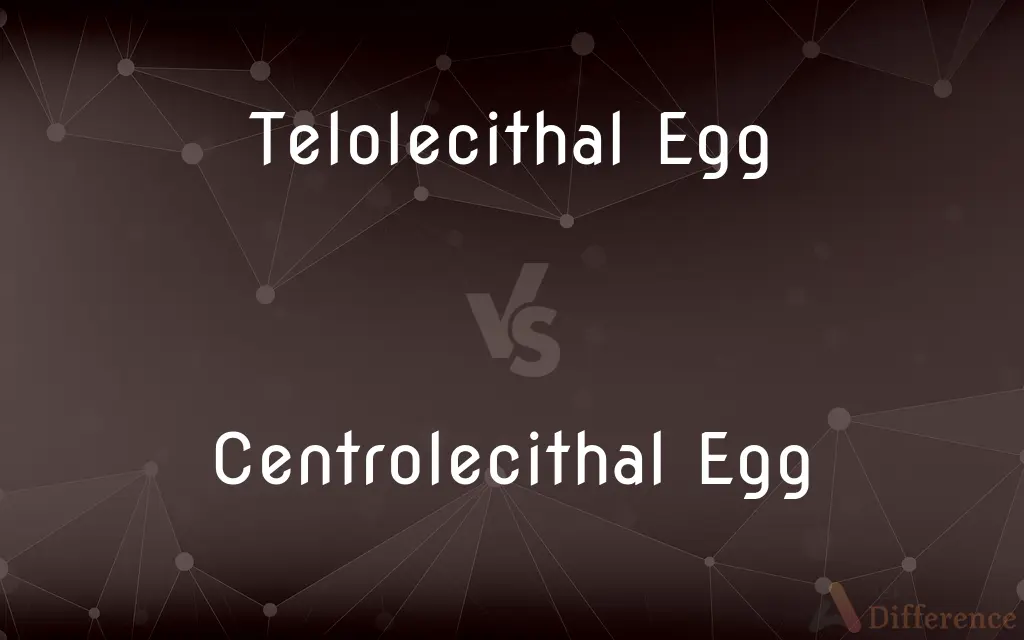Telolecithal Egg vs. Centrolecithal Egg — What's the Difference?
By Tayyaba Rehman — Published on January 6, 2024
Telolecithal eggs contain yolk concentrated at one end, common in birds and reptiles. Centrolecithal eggs have yolk centered in the middle, typical in insects and some arthropods.

Difference Between Telolecithal Egg and Centrolecithal Egg
Table of Contents
ADVERTISEMENT
Key Differences
Telolecithal Eggs are characterized by having a large amount of yolk concentrated at the vegetal pole of the egg. This type of egg is commonly found in birds, reptiles, and many fish. In contrast, Centrolecithal Eggs possess the yolk in the center of the egg and are surrounded by cytoplasm. These are typically seen in insects and some other arthropods.
In Telolecithal Eggs, the uneven distribution of yolk affects the pattern of cleavage during embryonic development, leading to meroblastic cleavage (incomplete division). On the other hand, Centrolecithal Eggs often undergo superficial cleavage, where only the cytoplasm around the yolk divides.
The presence of a large amount of yolk in Telolecithal Eggs serves as a nutrient source for the developing embryo, especially significant in organisms where the embryos develop externally. In Centrolecithal Eggs, the central yolk also provides nutrients, but the cleavage and developmental patterns are adapted to this central positioning of the yolk.
The development process in Telolecithal Eggs usually involves the formation of a blastodisc or germinal disc, where cell divisions occur, atop the yolk mass. In Centrolecithal Eggs, cellular divisions happen at the periphery of the egg as the central yolk is not divided.
Telolecithal Eggs are typically larger due to the extensive amount of yolk, supporting longer developmental periods outside the maternal body, as seen in birds. Centrolecithal Eggs, being smaller and with centrally located yolk, are adapted to the rapid developmental cycles typical in many insects.
ADVERTISEMENT
Comparison Chart
Yolk Distribution
Concentrated at one end (vegetal pole)
Centered in the middle
Commonly Found In
Birds, reptiles, many fish
Insects, some arthropods
Type of Cleavage
Meroblastic (incomplete division)
Superficial
Nutrient Source
Large yolk for nutrient supply
Central yolk, but with different development
Developmental Process
Formation of a blastodisc for cell division
Peripheral cellular divisions
Compare with Definitions
Telolecithal Egg
Found in birds, reptiles, and many fish.
Reptile eggs, being telolecithal, have substantial yolk content.
Centrolecithal Egg
Smaller with centrally located yolk.
Despite their smaller size, centrolecithal eggs efficiently support embryonic growth.
Telolecithal Egg
Larger due to extensive yolk.
The size of telolecithal eggs is influenced by their high yolk content.
Centrolecithal Egg
Common in insects and some arthropods.
Many arthropods produce centrolecithal eggs for reproduction.
Telolecithal Egg
Contains a large amount of yolk at the vegetal pole.
Bird eggs are classic examples of telolecithal eggs with dense yolk.
Centrolecithal Egg
Has yolk centered in the middle of the egg.
Centrolecithal eggs are typical in insects, with yolk in the center.
Telolecithal Egg
Undergoes meroblastic cleavage.
In telolecithal eggs, only a part of the egg cell undergoes division.
Centrolecithal Egg
Undergoes superficial cleavage.
In centrolecithal eggs, cell division occurs around the central yolk.
Telolecithal Egg
Supports longer development periods.
Telolecithal eggs provide necessary nutrients for the chick's development.
Centrolecithal Egg
Adapted for rapid developmental cycles.
Centrolecithal eggs facilitate the quick development of insect larvae.
Common Curiosities
Why do Telolecithal Eggs undergo meroblastic cleavage?
Due to the large amount of yolk, only the cytoplasmic part of the egg undergoes division.
What is a Centrolecithal Egg?
An egg with the yolk located in the center, typical in insects and some arthropods.
How does cleavage occur in Centrolecithal Eggs?
It involves superficial cleavage, where only the cytoplasm around the central yolk divides.
In what organisms are Centrolecithal Eggs found?
Mainly in insects and some arthropods.
How does yolk distribution in eggs affect the classification of species?
It provides insights into reproductive strategies and developmental processes of different species.
What is a Telolecithal Egg?
An egg with a large amount of yolk concentrated at one end, common in birds and reptiles.
What is the significance of yolk in Telolecithal Eggs?
It provides nutrients necessary for the development of the embryo.
Are Telolecithal Eggs larger than Centrolecithal Eggs?
Yes, typically, due to the greater amount of yolk.
What organisms typically produce Telolecithal Eggs?
Birds, reptiles, and many species of fish.
How does yolk distribution affect embryonic development?
It influences the pattern and type of cleavage during early development.
Are there evolutionary advantages to the different yolk distributions?
Yes, each type of yolk distribution offers specific advantages depending on the organism’s reproductive strategy and habitat.
What is the role of yolk in Centrolecithal Eggs?
It serves as a nutrient source, but the development pattern is adapted to the central yolk position.
Why are Centrolecithal Eggs suitable for insects?
They support the rapid developmental cycles typical in many insect species.
Do Telolecithal Eggs support external development?
Yes, they provide sufficient nutrients for the embryo to develop outside the maternal body.
Can the type of egg affect the growth rate of the organism?
Yes, the amount and distribution of yolk can influence the rate and pattern of embryonic growth.
Share Your Discovery

Previous Comparison
Fuzzification vs. DefuzzificationNext Comparison
Conservative Replication vs. Semiconservative ReplicationAuthor Spotlight
Written by
Tayyaba RehmanTayyaba Rehman is a distinguished writer, currently serving as a primary contributor to askdifference.com. As a researcher in semantics and etymology, Tayyaba's passion for the complexity of languages and their distinctions has found a perfect home on the platform. Tayyaba delves into the intricacies of language, distinguishing between commonly confused words and phrases, thereby providing clarity for readers worldwide.













































